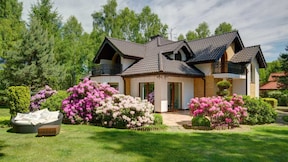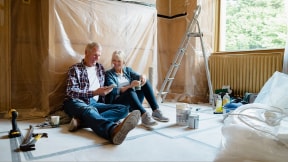Your guide to green architecture

Green architecture is hardly a new concept, but it’s one that’s cultivating increased attention. At its core, green architecture is a philosophy that revolves around building structures with minimal impact on the environment. As consumers become more conscious about conserving the environment and energy efficiency, this style of design is gaining interest among homeowners. To better understand green architecture, let’s take a closer look at its history and the ways it’s being employed today.
What is green architecture?
So, what is green architecture? Green architecture (sometimes referred to as sustainable or eco-friendly architecture) seeks to design and construct buildings with as little negative impact on the environment as possible. This generally means that green architects favor sustainable materials and energy-efficient design — possibly even coming up with carbon-negative designs if the situation allows. Basically, green architecture seeks to deliver the efficiency and aesthetics of a traditional modern home while also being mindful of the Earth and the resources consumed by the construction process.
History of green architecture and design
As we mentioned earlier, for much of human history, architecture was inherently green. Let’s look at some historical examples of green architecture and materials:
- Adobe homes: Adobe is a Spanish word for “mudbrick,” and it lives up to its name. Made from earth and other organic materials, such as straw or dung, adobe is one of the earliest building materials. It’s been used globally, from Mesopotamia to the American Southwest, for over 10,000 years. Adobe requires little additional energy for its production, and is potentially strong enough to withstand earthquakes, making it sustainable both architecturally and as a general material. It’s also proven to be a good natural insulator, keeping dwellings warm at night and cool during hot days.
- Cave and hill dwellings: Building into (or under) the earth and using caves as dwellings are examples of ancient green architecture. These globally used methods share the natural cooling and heating properties of adobe and require fewer materials than many other structures throughout history.
- Evaporative cooling: Sustainable cooling systems are another way ancient civilizations used readily available resources to make their living spaces more comfortable during hot weather. In Persia, some residents used aqueducts called “qanats” to funnel water long distances to their homes. The evaporating water would then cool their living spaces. Ancient Egyptians used water evaporation in a similar way. Instead of creating underground channels, they would dampen fabric or grass mats and hang them over entryways. As the water evaporated, the living spaces would become more comfortable.
- Wind catchers: Many ancient Middle Eastern civilizations used tower-like structures called “wind catchers” to cool living spaces. The tall devices featured multiple openings designed to capture and direct breezes downwards, where they would circulate in and among the hot buildings.
While the Arts and Crafts movement of the late 19th century inspired a return to sustainable practices and materials, it wasn’t until the oil crisis of the 1970s that green architecture began resembling the initiatives we see today. In the wake of the crisis, designers began exploring modern methods of energy efficiency, such as solar panels, and revisiting some of the greener design methods of the past.
Elements of green architecture and design
In 1993, the U.S. Green Building Council was founded. This nonprofit is responsible for the development of the Leadership In Energy and Environmental Design (LEED) green building ratings systems. Since the USGBC was founded, green architecture has grown to include regenerative design, net-zero energy buildings, and data-driven practices. While there are many ways to be “green,” there are some key principles that designers tend to abide by.
- Resource conservation: As the old saying goes, “Waste not, want not.” Green design puts heavy emphasis on things like water conservation, recycling and smart material selection. This might mean deploying practices such as rainwater collection, or simply using materials that are recycled or have a low environmental impact.
- Energy efficiency: Conserving energy, whether electric, gas, solar or otherwise, is an important part of green designs, which often utilize energy-efficient lighting, solar and wind power and strategic insulation to minimize energy consumption and loss whenever possible.
- Site planning: Green architecture seeks to be considerate of the land it occupies. This means taking care to live in greater harmony with the local ecosystem and promote biodiversity.
What is a green building?
Now that we’ve familiarized ourselves with the history and elements of green design, let’s take a closer look at green buildings themselves. While green buildings can take many forms, sustainability is at the heart of a green building, with design strategies, materials and technology that all make this a priority.
Common features of green buildings
- Solar panels: Solar paneling converts sunlight into electricity, making them a valuable source of clean, green, renewable power.
- Rainwater harvesting: The collection of rainwater for domestic or industrial uses is a sustainable water management practice that conserves natural resources and may help reduce strain on other water supplies.
- Green roofing: “Living roofs,” or green roofs are rooftops that are enriched with soil and vegetation. These trendy rooftop farms and gardens have more benefits to the environment than you may think. They're often energy-efficient, contribute to greater biodiversity and even help with stormwater management. Their aesthetic appeal and potential promise of fresh produce doesn’t hurt, either.
- Daylighting: The practice of designing interiors to maximize sunlight, using skylights and expansive windows, is known as “daylighting.” Daylighting reduces the need for energy consumption while draping a space in gorgeous, natural light.
- Energy efficient lighting systems: Fluorescent and LED lights are both versatile and energy efficient methods of lighting. When paired with automatic lighting controls and proper maintenance, these methods allow for minimally wasteful illumination.
- Natural ventilation: People of the ancient world were onto something with their natural ventilation and cooling methods. The use of atriums, courtyards and other designs that promote cross-ventilation allows for energy-efficient cooling and air circulation.
- Energy efficient HVAC systems: Thanks to technological advancement, HVAC systems aren’t the energy suck that they used to be. Energy-efficient heating, ventilation and cooling systems help reduce the environmental impact of their respective technologies, and generally mean a lower utility bill to boot.
- Recycled and reclaimed materials: While using recycled and reclaimed materials such as wood has become trendy, it’s a practice that is hard to argue with. Reclaimed steel, glass, concrete and even plastics are examples of materials that both minimize the environmental impact of construction and conserve precious resources.
- Low-flow fixtures: Ever see those toilets with two different flush settings? They’re a prime example of a “low-flow” fixture designed to reduce water consumption. Other fixtures, such as low-flow faucets and showerheads, also help to reduce water waste. With today’s technology, low-flow doesn’t have to mean low pressure, so you don’t have to sacrifice that satisfying shower massage to help the planet.
- Local sourcing: Sourcing building materials and other design components locally reduces energy-sapping methods of transportation, potentially saving time, money and the environment. Looking locally is also a way to support small businesses and invest in your community.
While not every green building employs every one of these features, most will make use of several of them.
In summary
While green architecture has been around for thousands of years, this philosophy of design has regained relevance in the last century. An emphasis on energy efficiency, sustainability and low environmental impact are all core features of green architecture — features which could potentially help the planet and its inhabitants for years to come.



